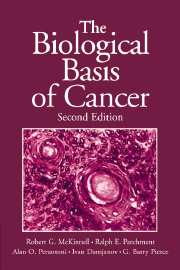Book contents
- Frontmatter
- Contents
- Preface
- Introduction: Letters illustrating clinical aspects of cancer
- 1 The pathology of cancer
- 2 Invasion and metastasis
- 3 Carcinogenesis
- 4 Genetics and heredity
- 5 Cancer-associated genes
- 6 Cancer in nonhuman organisms
- 7 Epidemiology
- 8 Lifestyle: Is there anything more important?
- 9 The stem cell basis of cancer treatment: concepts and clinical outcomes
- 10 Oncology: The difficult task of eradicating caricatures of normal tissue renewal in the human patient
- Appendix: Description of selected tumors
- Glossary
- References
- Index
- Plate section
5 - Cancer-associated genes
Published online by Cambridge University Press: 05 June 2012
- Frontmatter
- Contents
- Preface
- Introduction: Letters illustrating clinical aspects of cancer
- 1 The pathology of cancer
- 2 Invasion and metastasis
- 3 Carcinogenesis
- 4 Genetics and heredity
- 5 Cancer-associated genes
- 6 Cancer in nonhuman organisms
- 7 Epidemiology
- 8 Lifestyle: Is there anything more important?
- 9 The stem cell basis of cancer treatment: concepts and clinical outcomes
- 10 Oncology: The difficult task of eradicating caricatures of normal tissue renewal in the human patient
- Appendix: Description of selected tumors
- Glossary
- References
- Index
- Plate section
Summary
Introduction
Over the past twenty years, more than a hundred genes have been identified that can convert nontumorigenic tissue-cultured test cells from rodent cell lines to a transformed phenotype, that is, foci of piled-up and crisscrossed cells that grow in soft agar and form tumors when explanted into immunocompromised rodents. These dominant transforming genes, or oncogenes, encode proteins involved in signal transduction or cell cycle regulation and affect a variety of normal cellular functions, including apoptosis, proliferation, cell differentiation, and adhesion. When overexpressed or structurally altered by point mutation, deletion, or fusion, most oncogenic proteins selectively induce the proliferation of cells that express them. More recently, studies of families predisposed to specific types of cancers have yielded a growing number of recessive tumor suppressor genes. Loss of suppressor function by deletion or point mutation of both gene copies allows cells to proliferate unregulated or with reduced restraints. The discovery of both oncogenes and suppressor genes has proven pivotal in our understanding of the mechanisms of carcinogenesis by allowing scientists to focus on the genetic targets of carcinogens and thus finally link the details of carcinogen activation, adduct formation and repair, and neoplastic conversion and metastasis with definable molecular events. Furthermore, targeting of these genes with drugs that modulate their function has already led to effective therapies for human cancers.
- Type
- Chapter
- Information
- The Biological Basis of Cancer , pp. 145 - 194Publisher: Cambridge University PressPrint publication year: 2006



